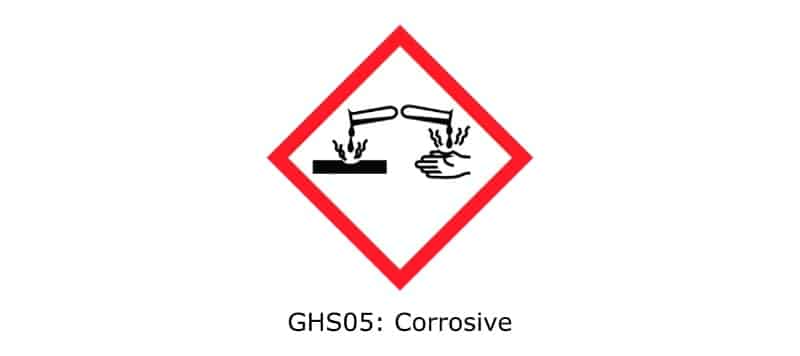We all know acids are dangerous chemicals, and you should handle them carefully. That is drilled into us from quite early on in our scientific education.
But what about handling bases in the lab?
Like acids, they burn through things. Like acids, they are used widely in the lab. Yet base safety is seldom mentioned.
This lack of base safety may be because you will be safe if you treat them with the same general care as an acid. But they do possess several properties that are, in my view, rarer among acids. Consequently, they present some unique hazards.
So, let’s discuss bases, some of their hazards, and how to handle them safely.
What Is a Base?
There are two definitions of a base you need to know:
What is a Brønsted–Lowry base?
A Brønsted–Lowry base is any species that can accept a proton. This definition is what most readers will be familiar with and applies to common bases such as sodium and potassium hydroxide solutions.
What is a Lewis base?
A Lewis base is any species that can donate a pair of electrons. This definition may be less familiar to readers. It applies to formal anions, such as sulfate and fluoride. But it also applies to species possessing lone pairs of electrons, such as amines.
Thus, Lewis acid-base theory essentially expresses Brønsted–Lowry acid-base theory in terms of species’ electronic structure.
Basicity (and acidity) is relative and can be defined more rigorously using terms of proton concentration (pH) and the negative log of the acid dissociation constant (pKa).
We’ll expand on this later in the article, but be sure to check out Bitesize Bio’s definite guide pH, pKa, and pI if this is an area of your knowledge you would like to expand.
What Are the Hazards of Bases?
A small disclaimer—these properties aren’t uniquely limited to bases. It’s my observation, however, that in a laboratory setting, the properties listed below occur more frequently for bases than acids.
Are Bases Flammable?
Bases Can Also Be Flammable.
We’ve seen that the Lewis definition of a base extends to species containing a lone pair of electrons. This definition includes organic solvents such as pyridine. Low molecular weight amines such as ethylamine are also basic and flammable.
Also, inorganic bases such as sodium and potassium hydroxide are mixed with flammable alcohols to produce cleaning solutions known as base baths.
These can catch fire if combined with a chemical that reacts exothermically with water or bases. For example, the accidental addition of alkali metal to a base bath caused a fire in the biomedical building at the University of St. Andrews.
You’ll Work With Bases in All States of Matter
In my experience, when working with acids in the lab, I usually handle a solution in which the acid is the solute. For example, the 5 M HCl solution that I use to adjust the pH of my buffers.
Sometimes, I might work with an acidic solvent such as glacial acetic acid.
I don’t routinely handle acidic solids or gases. But I sometimes handle basic solids and gases as well as basic solutions.
I’d wager your day-to-day lab experience is roughly the same as mine, so I bet you handle basic solids and gases too.
Let me explain.
Sodium, potassium, and calcium hydroxide are all solid-state bases we use in the lab. Quaternary amine-based anion exchange resins are another. Potassium fluoride is another.
Ammonia is a basic gas. Medicinal chemists might use it to introduce nitrogen atoms into their lead compounds during synthesis. Or they might dissolve it in water to create an ammonia solution first, then use this to introduce nitrogen atoms.
The fact that bases are found in the lab as solids, liquids, gases, and solutions means the corresponding exposure routes are comparatively varied. Something to think about the next time you are planning your experiments.
Bases Can Saponify Your Skin
We use bases to make soap. A triglyceride is an ester formed between glycerol and three fatty acids. Heating triglycerides in the presence of soap converts them into the constituent fatty acid salts and glycerol. This process is called saponification.
The phospholipid bilayer of your skin cells is chemically similar to a triglyceride. The difference between the two is, in the phospholipid bilayer, a phospholipid takes the place of the third fatty acid.
The lipid bilayer is a perfect candidate for saponification. If you have ever got a small amount of sodium hydroxide solution or another strong base on your skin, you might have noticed it felt slippery. This sensation is probably due to the saponification of your skin’s outermost (and likely dead) layers!
So be careful when handling bases—especially strong bases—wounds can’t heal if there’s no flesh on which to form a scab!
There are other reasons bases can feel slippery. Some are just naturally quite viscous. Others are hygroscopic (attract water to themselves). Some are so soluble and attract so much water that they dissolve in it. This phenomenon is called deliquescence.
How to Handle Bases Safely in the Lab
I said at the start that if you treat them with the same general care as an acid, you will be safe. It might sound flippant, but it’s true. To be on the safe side, however, here are a few simple rules to adhere to when handling bases in the lab:
- Always wear PPE when handling them.
- Segregate them from acids, flammable liquids, oxidizers, and poisons.
- Take note of their exposure routes.
- Double-check if it’s flammable and handle it accordingly.
Caustic Refers Only to Strong Bases
Nothing particularly transformative about this fact, but it’s worth knowing.
Caustic and corrosive are not synonymous; you should only describe strong bases as caustic.
Caustic and corrosive are often used interchangeably, and both terms mean the same thing—the chemical in question can corrode organic matter and metals. But caustic refers specifically to strong bases.
There are many ways to define a “strong” base, but the most widely used definition is that a strong base is one that fully dissociates in an aqueous solution. Potassium hydroxide is an excellent example of a strong base.
To make matters more confusing, both share the same GHS hazard symbol:

Some Common Bases and Their Relative Strength
Bases fall on a scale of strength called the base dissociation constant, pKb. It’s calculated analogously to the acid dissociation constant, pKa. So a lower pKb means a stronger base, etc.
See Table 1 for a few common laboratory bases and their pKb values. [1]
Base | pKb |
Sodium hydroxide | 0.4 |
Calcium hydroxide* | 2.73, 1.4 |
Ammonia | 4.75 |
Pyridine | 8.75 |
Glycine** | 11.65, 4.22 |
*Calcium hydroxide has the formula Ca(OH)2, so it can donate two hydroxide anions per molecule. Thus, it has two pKb values.
| |
Fun fact: for any given ionizable group, pKb = 14 – pKa. Why not use this fact to make yourself a table of the pKb values for the basic amino acids lysine, arginine, and histidine?
Touching Base: A Summary of Handling Bases Safely in the Lab
We’ve looked at what a base is, discussed how to handle them, and pulled together some slightly random facts about bases in the lab.
Hopefully, in attempting to tease out some properties and hazards unique to handling bases in the lab, you have learned something helpful!
I’m sure there’s plenty I’ve forgotten to include, and if you have something you wish to add, please drop it in the comments section below. I’ll be happy to add them to the article.
Reference
- Haynes WM (2012) The handbook chemistry and physics, 93rd edition. CRC Press.







